
Tilburg is a city and municipality in the Netherlands, in the southern province of North Brabant. With a population of 222,601, it is the second-largest city or municipality in North Brabant after Eindhoven and the seventh-largest in the Netherlands as a whole.

Apeldoorn is a municipality and city in the province of Gelderland in the centre of the Netherlands. The municipality of Apeldoorn, including the of villages of Beekbergen, Loenen, Ugchelen and Hoenderloo, had a population of 165,525 on 1 December 2021. The western half of the municipality lies on the Veluwe ridge, with the eastern half in the IJssel valley.

Willem-Alexander is the King of the Netherlands.
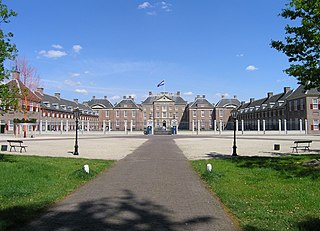
Het Loo Palace is a palace in Apeldoorn, Netherlands, built by the House of Orange-Nassau.

Soestdijk Palace is a palace formerly belonging to the Dutch royal family. It consists of a central block and two wings.

Noordeinde Palace is one of three official palaces of the Dutch royal family. Located in the city center of The Hague in the province of South Holland, it has been used as the official workplace of King Willem-Alexander and Queen Maxima since 2013. The Noordeinde Palace and its surrounding palace grounds are property of the Dutch State.

Huis ten Bosch is a royal palace in The Hague, Netherlands. It is one of three official residences of the Dutch monarch; the two others being the Noordeinde Palace in The Hague and the Royal Palace of Amsterdam.

The Royal Palace of Amsterdam in Amsterdam is one of three palaces in the Netherlands which are at the disposal of the monarch by Act of Parliament. It is situated on the west side of Dam Square in the centre of Amsterdam, opposite the War Memorial and next to the Nieuwe Kerk.

Willem II, also known as Willem II Tilburg, is a Dutch football club based in Tilburg, Netherlands. They play in the Eredivisie, the top tier of Dutch football, following promotion from the Eerste Divisie in the 2023–24 season. The club was founded on 12 August 1896 as Tilburgia. On 12 January 1898, the club was renamed Willem II after Dutch king William II of the Netherlands (1792–1849), who, as Prince of Orange and commander of the Dutch army, had his military headquarters in Tilburg during the Belgian uprising of 1830, spent much time in the city after becoming king, and died there.

The City Hall in Haarlem is the seat of the city's government. It was built in the 14th century replacing the Count's castle.
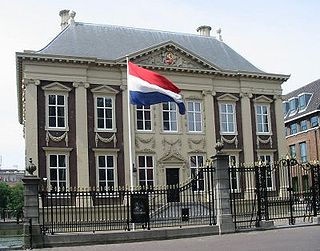
Jacob van Campen was a Dutch artist and architect of the Golden Age.

The Nieuwe Kerk is a 15th-century church in Amsterdam located on Dam Square, next to the Royal Palace. Formerly a Dutch Reformed Church parish, it now belongs to the Protestant Church in the Netherlands.
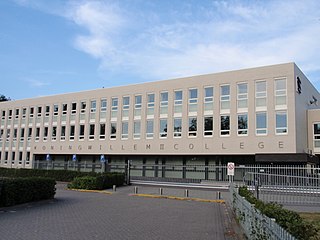
Koning Willem II College is a school in Tilburg in the Netherlands. It was established in 1866 and is named after King Willem II. The school was founded in the former royal palace in Tilburg, the present City Hall, of which the construction was commissioned by King William II himself. In 1934 the school moved from the former palace to the new location a new and much bigger building at the Ringbaan Oost in Tilburg. In 1971 the school moved to its present location on the Tatraweg.

The Royal Palace of Brussels is the official palace of the King and Queen of the Belgians in the centre of the nation's capital, Brussels. However, it is not used as a royal residence, as the king and his family live in the Royal Palace of Laeken in northern Brussels. The website of the Belgian Monarchy describes the function of the Royal Palace as follows:
The Royal Palace is where His Majesty the King exercises his prerogatives as Head of State, grants audiences and deals with affairs of state. Apart from the offices of the King and the Queen, the Royal Palace houses the services of the Grand Marshal of the Court, the King's Head of Cabinet, the Head of the King's Military Household and the Intendant of the King's Civil List. The Royal Palace also includes the State Rooms where large receptions are held, as well as the apartments provided for foreign Heads of State during official visits.

Kneuterdijk Palace is a former royal palace of the Netherlands located in The Hague, nowadays the seat of the Council of State. Built in 1716 in the Louis XIV style by architect Daniel Marot, it was commissioned by Count Johan Hendrik of Wassenaer-Obdam, member of the House of Wassenaer. The palace served as a residence for King William II of the Netherlands and his wife Queen Anna Paulowna in the first half of the 19th century, when he was still the crown prince. William II added several buildings designed in the English Tudor style, of which only the so-called “Gothic Hall” has survived. The hall was designed after the great dining hall of Christ Church, Oxford, of which William II was an alumnus.

The monarchy of the Netherlands is governed the country's Constitution, roughly a third of which explains the mechanics of succession, accession, and abdication; the roles and duties of the monarch; the formalities of communication between the States General of the Netherlands; and the monarch's role in creating laws.
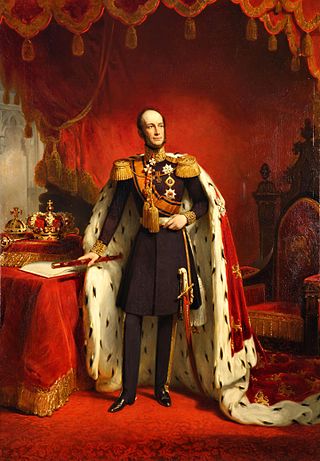
William II was King of the Netherlands, Grand Duke of Luxembourg, and Duke of Limburg.

Constant Cornelis Huijsmans was a Dutch art teacher and painter, whose roots go back to the seventeenth-century Antwerp of the landscape painter Cornelis Huysmans (1648–1727). Paintings of the latter are to be found at the Louvre in Paris and at the Hermitage Museum in Saint Petersburg, Russia. Earlier generations of the Huijsmans family used to spell their family name slightly differently, as Huysmans.

The Koninklijke Schouwburg is a theater in the city center of The Hague. The theater was built in 1766 and has been in use as theater since 1804. From 2017 it is one of the theaters in use by the national theater company Het Nationale Theater, but also other companies perform in the Schouwburg.
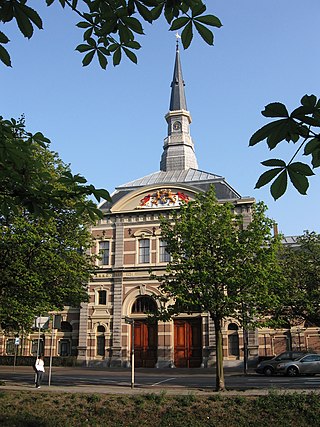
The Royal Stables is a collection of equestrian stables of the Dutch royal family, the House of Orange-Nassau. It is a Rijksmonumental building that is part of the royal palace grounds located in the city center of The Hague in the Netherlands. The Noordeinde Palace and the Palace Gardens are also part of this same palace complex. The Noordeinde Palace and its grounds are the official workplace of the Dutch King Willem-Alexander.

![Lithography by Wilhelmus Cornelius Chimaer van Oudendorp [nl] (1822-1873) of the New Royal Palace in Tilburg in 1849. In the drawing there's a mistake. The artist drew in the facade of the palace only six of the original eight windows on both sides of the entrance adjoining series of windows. Nieuwkoninklijkpaleistetilburg.jpg](http://upload.wikimedia.org/wikipedia/commons/thumb/b/ba/Nieuwkoninklijkpaleistetilburg.jpg/220px-Nieuwkoninklijkpaleistetilburg.jpg)
























